As loving pet parents, we constantly strive to provide the best for our furry companions, and that includes their diet. But with so many human foods that can be harmful, navigating what your dog can and cannot eat can be a minefield. While numerous ingredients pose risks, when it comes to meat, the question often arises: “What Is The One Meat That Dogs Should Avoid?” The answer isn’t always singular, as several types and preparations of meat can be detrimental. However, raw or undercooked meat stands out as a primary concern due to its potential for bacterial contamination and other hazards, closely followed by excessively fatty cuts and processed meats. Understanding these specific dangers is crucial for protecting your dog’s health and preventing common food-related illnesses.
Pet poisonings are a significant threat, with hundreds of thousands occurring annually in the United States alone. While not all are food-related, common household foods are a major contributor. This comprehensive guide aims to arm you with the knowledge to distinguish safe meats from harmful ones, ensuring your canine companion enjoys a healthy and happy life free from dietary risks. For a broader overview of dangerous foods, consult our list of what dogs can’t eat.
Why Certain Meats Are Toxic to Dogs
Canine digestion and metabolism differ significantly from our own, allowing humans to safely consume many foods that are harmful to dogs. Their bodies process certain substances, including components found in various meats, very differently.
For instance, the high-fat content in certain cuts of meat can be incredibly difficult for a dog’s digestive system to handle. Unlike humans, dogs are more prone to developing acute pancreatitis, a life-threatening illness, from sudden high-fat meals. Furthermore, bacterial contaminants like Salmonella and E. coli, often present in raw meats, can cause severe gastrointestinal distress, systemic infections, and even death in dogs, just as they can in humans. Bones, whether raw or cooked, also present distinct choking hazards and potential for internal injuries.
Food toxicity can vary based on a dog’s size, breed, and overall health. A small dog might react more severely to a tiny amount of problematic food than a large breed. Puppies and senior dogs, with their less developed or compromised immune systems, are also at higher risk. Always consult your veterinarian if you have any questions about specific foods or if your dog ingests something questionable.
The Primary Concerns: Raw and Undercooked Meat
When considering “the one meat dogs should avoid,” raw or undercooked meat frequently tops the list due to multiple inherent dangers. Many owners are drawn to raw food diets, believing they mimic a dog’s ancestral diet. However, veterinary experts widely advise against feeding raw or undercooked meat for several critical reasons.
1. Bacterial Contamination (Salmonella, E. coli, Listeria)
Raw meat, including chicken, beef, pork, and fish, is a common carrier of harmful bacteria such as Salmonella, E. coli, Campylobacter, and Listeria. These pathogens can cause severe illness in dogs, leading to symptoms like vomiting, diarrhea (often bloody), lethargy, and fever. In severe cases, these bacterial infections can be fatal. Moreover, your dog can become a carrier of these bacteria, posing a risk of transmission to humans, especially children, the elderly, or immunocompromised individuals in the household. Cooking meat thoroughly eliminates most of these dangerous bacteria, making it significantly safer for consumption.
2. Bone Hazards
Raw meat often comes with bones, which present a serious choking hazard for dogs. Even if swallowed, bones can cause internal damage, including:
- Choking: Small bones can get lodged in the throat.
- Blockages: Larger pieces can cause intestinal obstruction, requiring emergency surgery.
- Internal Punctures: Sharp bone fragments can splinter and perforate the stomach or intestinal lining, leading to life-threatening infections.
- Dental Damage: Hard bones can break or chip teeth.
While the prompt asks what bones can I feed my dog, generally, it’s safer to avoid giving bones from raw meat due to these risks.
3. Parasites
Raw meat can also harbor parasites like tapeworms, roundworms, and Toxoplasma gondii, which can infect your dog. Thorough cooking destroys these parasites, making the meat safe. Regular deworming protocols are essential, but preventing exposure to parasites through raw meat is a crucial preventative measure.
Beyond Raw: Other Meats to Approach with Caution
While raw meat holds a top spot for avoidance, other forms and preparations of meat also pose significant risks to dogs.
1. Fatty Meats (Chicken & Turkey Skin, Ham, Bacon, Fatty Trimmings)
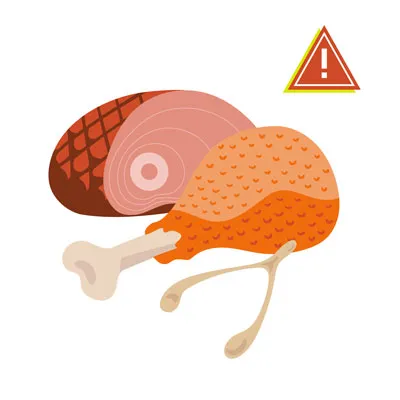 Dog looking at a slice of ham, symbolizing caution with fatty meats
Dog looking at a slice of ham, symbolizing caution with fatty meats
High-fat meats are a major culprit for canine digestive issues. Items like chicken or turkey skin, ham, bacon, and other fatty cuts are incredibly tempting but extremely dangerous. Their high fat content can rapidly lead to acute pancreatitis, an inflammation of the pancreas that is incredibly painful and potentially life-threatening for dogs. Symptoms of pancreatitis include severe vomiting, diarrhea, abdominal pain, lethargy, and loss of appetite. It’s far better to dispose of these fatty scraps than to offer them as a treat.
2. Processed Meats (Sausages, Deli Meats, Hot Dogs)
Processed meats, while cooked, are often laden with high levels of sodium, artificial preservatives, and unhealthy fats. These ingredients can lead to:
- Salt Poisoning: Excessive salt intake can disrupt a dog’s fluid balance, causing tremors, seizures, diarrhea, or even coma.
- Digestive Upset: Preservatives and high fat can irritate the digestive system, leading to vomiting and diarrhea.
- Unnecessary Calories: These items contribute to canine obesity without providing significant nutritional benefits.
3. Cooked Bones
Unlike raw bones, which can still splinter, cooked bones are significantly more brittle and prone to breaking into sharp shards. These fragments can easily get stuck in a dog’s throat, cause internal punctures, or lead to dangerous intestinal blockages. Always ensure any meat given to your dog is completely deboned.
4. Heavily Seasoned or Spiced Meats
Meat that has been seasoned for human consumption often contains ingredients toxic to dogs. Onions, garlic, chives, leeks (allium family), and nutmeg are common spices that can cause severe health problems.
- Allium Plants: Onions and garlic, even in powdered form, contain sulfoxides and disulfides that damage red blood cells, leading to potentially fatal anemia.
- Nutmeg: This spice can cause hallucinations, severe vomiting, and central nervous system effects in dogs.
- Excess Salt and Other Spices: Beyond the specific toxic ingredients, excessive salt or other strong spices can irritate a dog’s digestive tract, leading to vomiting, diarrhea, and discomfort.
5. Meat with Harmful Additives or Sweeteners
Some processed meats or meat-containing products might contain artificial sweeteners like xylitol. Xylitol is extremely toxic to dogs, causing a rapid and dangerous drop in blood sugar (hypoglycemia) and potential liver failure. Always check ingredient labels carefully before sharing any human food with your pet, especially if it’s processed or sugar-free.
Comprehensive List of Common Foods Dogs Cannot Eat
While focusing on meat is crucial, it’s important to remember that many other common household foods are dangerous and often toxic to dogs. This list, while not exhaustive, rounds up many of the items your dog should never ingest.
1. Alcohol
 Dog with a glass of red wine, highlighting alcohol danger
Dog with a glass of red wine, highlighting alcohol danger
Even small amounts of alcohol can have deadly effects on dogs due to their smaller size and different metabolism. Symptoms include vomiting, breathing problems, coma, or even death.
2. Apple, Apricot, Cherry, & Plum Seeds/Pits
 Apple core with seeds, apricot pits, and cherry stems, illustrating fruit seed dangers for dogs
Apple core with seeds, apricot pits, and cherry stems, illustrating fruit seed dangers for dogs
While the flesh of these fruits can be safe, their seeds and pits contain cyanide, which is toxic. Ingestion can cause vomiting, irregular heartbeat, seizures, and respiratory issues. It’s best to avoid these parts entirely.
3. Avocado
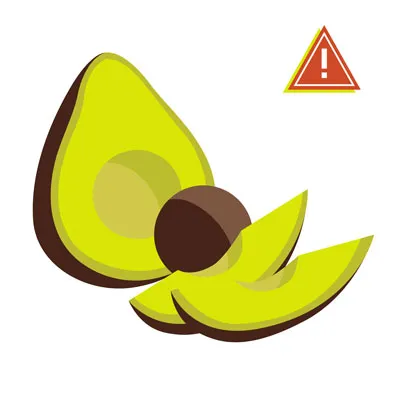 Whole and sliced avocado, highlighting its toxicity for dogs
Whole and sliced avocado, highlighting its toxicity for dogs
Avocados contain persin, which can be toxic to dogs in large quantities, though its effect varies. The pit also poses a significant choking hazard or can cause gastrointestinal obstruction.
4. Broccoli
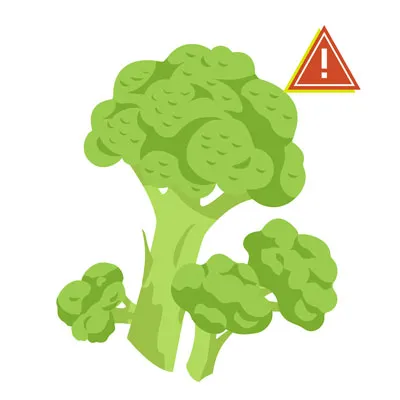 Fresh broccoli florets, emphasizing caution with this vegetable for dogs
Fresh broccoli florets, emphasizing caution with this vegetable for dogs
Small amounts of broccoli are generally okay, but large quantities can cause gastrointestinal irritation due to isothiocyanates. Stalks can also be a choking hazard.
5. Caffeine and Coffee Grounds
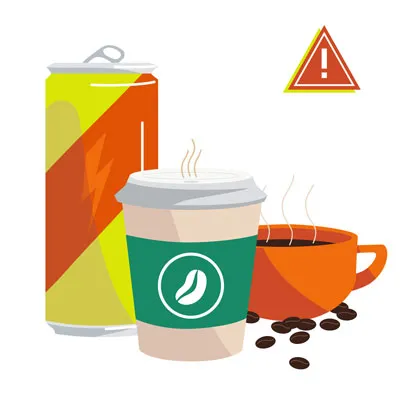 Coffee beans and grounds, warning against caffeine for dogs
Coffee beans and grounds, warning against caffeine for dogs
Caffeine, found in coffee, tea, and energy drinks, contains methylxanthines which can cause vomiting, diarrhea, seizures, and irregular heartbeats. These effects can be fatal.
6. Chocolate
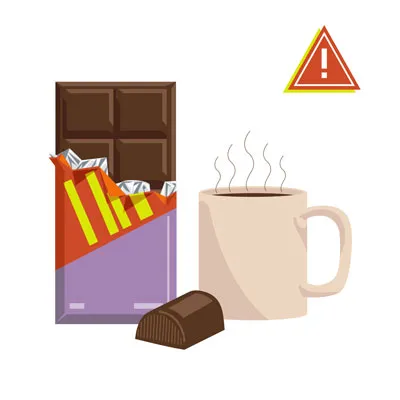 Various types of chocolate, stressing its high toxicity for dogs
Various types of chocolate, stressing its high toxicity for dogs
One of the most well-known toxic foods for dogs, chocolate contains theobromine and caffeine. Darker chocolate has higher concentrations and is more dangerous. Symptoms include hyperactivity, vomiting, diarrhea, abnormal heart rhythm, and seizures. Any ingestion warrants immediate veterinary attention.
7. Grapes and Raisins
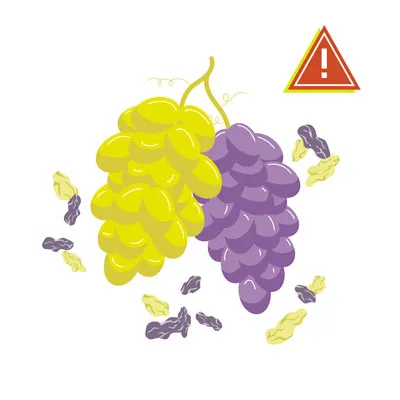 Bunches of grapes and dried raisins, indicating their severe toxicity to dogs
Bunches of grapes and dried raisins, indicating their severe toxicity to dogs
These fruits are highly toxic and can cause acute kidney failure in dogs, even in small amounts. Symptoms include vomiting, diarrhea, loss of appetite, and changes in urination. For a comprehensive understanding of what fruits can puppies not eat, refer to our dedicated guide.
8. Macadamia Nuts, Almonds, and Pistachios
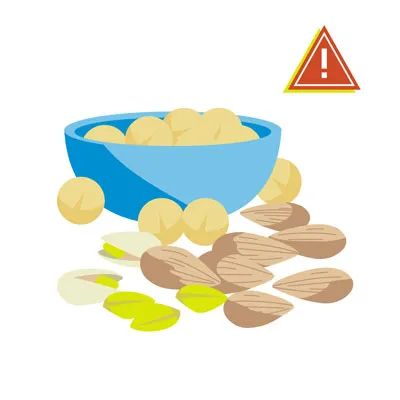 Macadamia nuts, almonds, and pistachios, highlighting nut dangers for dogs
Macadamia nuts, almonds, and pistachios, highlighting nut dangers for dogs
Macadamia nuts are particularly toxic, causing weakness, overheating, and vomiting. Other nuts like almonds and pistachios are primarily choking hazards or can cause digestive upset if flavored or salted.
9. Milk and Dairy Products
 Glass of milk and a cheese wedge, representing dairy products for dogs
Glass of milk and a cheese wedge, representing dairy products for dogs
Many dogs are lactose intolerant and can experience diarrhea and gas from cow’s milk. While small amounts of low-fat cheese might be acceptable for some, high-sugar and high-fat dairy like ice cream should be avoided.
10. Mushrooms
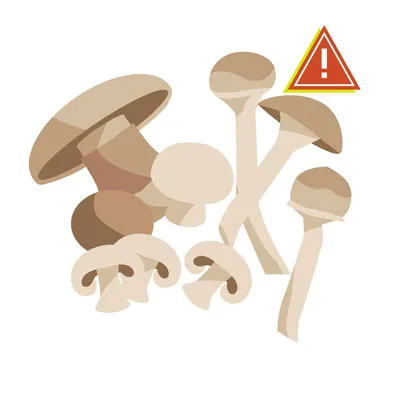 Assortment of wild mushrooms, warning against their consumption by dogs
Assortment of wild mushrooms, warning against their consumption by dogs
It’s safest to avoid feeding dogs mushrooms entirely, as many wild varieties are highly toxic and can cause kidney and liver failure, hallucinations, and red blood cell damage. Even store-bought mushrooms are best avoided to err on the side of caution.
11. Nutmeg and Cinnamon
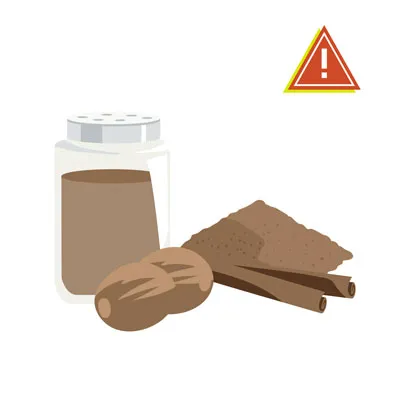 Nutmeg and cinnamon sticks, indicating their potential harm to dogs
Nutmeg and cinnamon sticks, indicating their potential harm to dogs
Nutmeg contains myristicin, which can cause hallucinations and severe vomiting. Cinnamon isn’t toxic but can irritate a dog’s mouth and, in large amounts, lead to dangerously low blood sugar.
12. Onions, Garlic, Chives, and Leeks
 Onions, garlic cloves, and chives, illustrating allium toxicity for dogs
Onions, garlic cloves, and chives, illustrating allium toxicity for dogs
These allium plants contain compounds that damage red blood cells, leading to anemia. All forms (raw, cooked, powdered) are dangerous, and certain breeds like Akitas and Shiba Inus are particularly sensitive. These are frequently found in meat preparations, so beware of seasoned foods.
13. Salt
 Salt shaker and a small pile of salt, warning against excessive sodium for dogs
Salt shaker and a small pile of salt, warning against excessive sodium for dogs
Excessive salt intake can cause sodium ion poisoning, leading to tremors, seizures, diarrhea, vomiting, and even coma. This is particularly relevant when considering processed or heavily seasoned meats.
14. Spicy Food
 Red chili peppers, symbolizing spicy food to avoid for dogs
Red chili peppers, symbolizing spicy food to avoid for dogs
Hot and spicy foods can cause severe gastrointestinal upset, including vomiting, stomach ulcers, and diarrhea, which can be very painful for your dog.
15. Sugar-Free Gum and Candy (Xylitol)
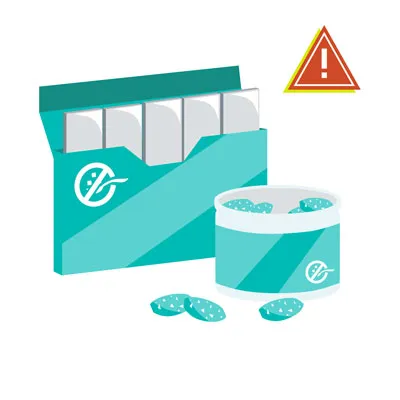 Sugar-free gum and candy, highlighting the danger of xylitol for dogs
Sugar-free gum and candy, highlighting the danger of xylitol for dogs
Xylitol, a common artificial sweetener, is highly toxic to dogs. It causes a rapid drop in blood sugar and can lead to liver failure. Even small amounts can be deadly. Always check ingredient lists, especially in baked goods.
16. Tomatoes and Raw Potatoes
 Ripe tomatoes and raw potatoes, indicating caution with these vegetables for dogs
Ripe tomatoes and raw potatoes, indicating caution with these vegetables for dogs
Green parts of tomato plants and unripe tomatoes contain solanine, which is toxic. Similarly, raw potatoes also contain solanine. Cooked, plain potatoes (without additives) and ripe red tomatoes are generally safe in moderation.
17. Tobacco
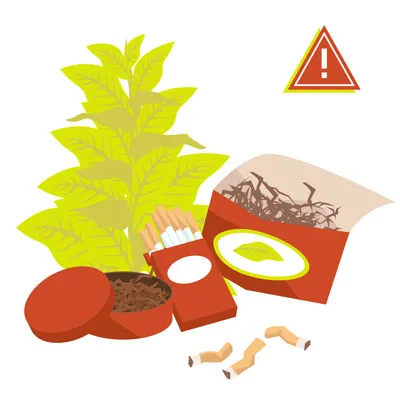 Cigarettes and tobacco, emphasizing the danger of nicotine exposure for dogs
Cigarettes and tobacco, emphasizing the danger of nicotine exposure for dogs
Nicotine in tobacco products is a potent toxin, causing vomiting, diarrhea, abnormal heart rates, agitation, seizures, and even coma. Immediate veterinary attention is critical if a dog ingests tobacco.
18. Yeast and Raw Dough
 Raw dough rising in a bowl, warning against yeast and raw dough for dogs
Raw dough rising in a bowl, warning against yeast and raw dough for dogs
Raw dough can expand in a dog’s stomach, causing severe pain and potentially life-threatening gastric torsion or rupture. The fermenting yeast also produces alcohol, leading to alcohol toxicity.
19. Rhubarb
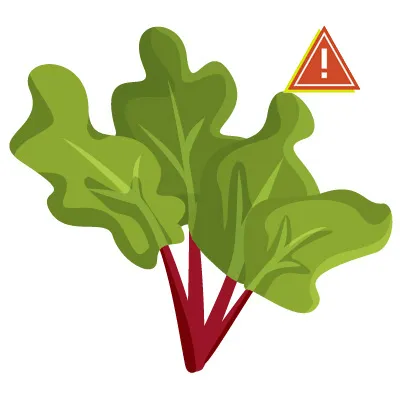 Rhubarb stalks, warning against this plant for dogs
Rhubarb stalks, warning against this plant for dogs
Rhubarb contains soluble calcium oxalate crystals, which can cause a dangerous drop in calcium levels, leading to renal failure, tremors, and weakness if ingested in large quantities.
20. Star Fruit
 Sliced star fruit, indicating its danger to dogs due to oxalate crystals
Sliced star fruit, indicating its danger to dogs due to oxalate crystals
Similar to rhubarb, star fruit also contains soluble calcium oxalate crystals and should be avoided by dogs.
21. Flavored Water and Seltzer Water
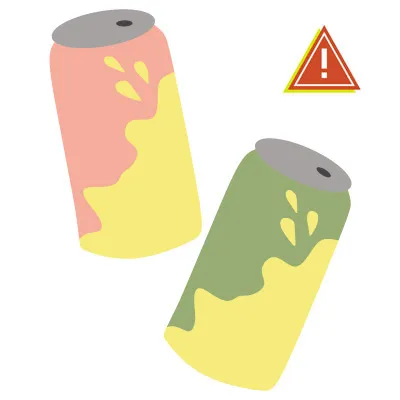 Seltzer water bottle and glass, advising plain water for dogs
Seltzer water bottle and glass, advising plain water for dogs
Stick to fresh, clean water for your dog. Flavored and seltzer waters can contain added sugars, salts, or artificial sweeteners that are harmful. Plain seltzer might cause gas and bloating.
Understanding what are some foods that dogs can’t eat is vital for responsible pet ownership.
Safe Foods for Dogs: A Balanced Perspective
While the list of forbidden foods is extensive, there are plenty of healthy and safe human foods that dogs can enjoy in moderation. Providing a varied diet with safe additions can enhance their nutrition and enjoyment.
1. Plain, Cooked Meats
Lean, boneless, plain, and thoroughly cooked meats are generally safe and nutritious for dogs.
- Chicken and Turkey: Remove all skin, fat, and bones. Offer small, unseasoned pieces as a protein-rich treat.
- Beef: Lean cuts of beef, cooked plain, can be a good source of protein. Avoid fatty cuts, seasoning, and bones.
2. Fish and Shrimp
 Cooked shrimp and fish fillets, indicating safe seafood for dogs
Cooked shrimp and fish fillets, indicating safe seafood for dogs
Plain, fully cooked, and deboned fish (like salmon and sardines) and shrimp are excellent sources of protein and Omega-3 fatty acids. Ensure they are unseasoned and served in moderation to avoid excess mercury or sodium. Canned tuna (packed in water) is also safe in small amounts.
3. Eggs
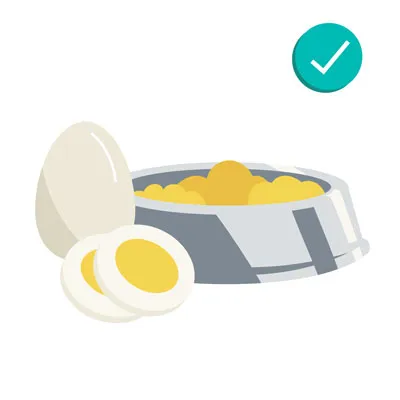 Cooked eggs, emphasizing their safety and nutritional value for dogs
Cooked eggs, emphasizing their safety and nutritional value for dogs
Fully cooked eggs are a fantastic source of protein and can be a tasty treat, especially for dogs with an upset stomach. Scrambled or hard-boiled are good options.
4. Apples, Oranges, and Bananas
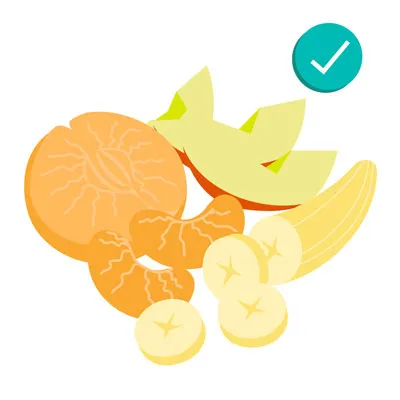 Slices of apple, orange, and banana, showcasing safe fruits for dogs
Slices of apple, orange, and banana, showcasing safe fruits for dogs
- Apples: Remove cores and seeds, as they contain cyanide. The fleshy part is safe and crunchy.
- Oranges: Small amounts are fine, but remove seeds and peel.
- Bananas: A great source of potassium, given in moderation without the peel.
5. Blueberries and Blackberries
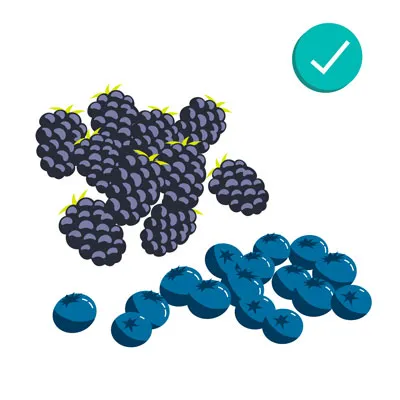 Fresh blueberries and blackberries, highlighting their antioxidant benefits for dogs
Fresh blueberries and blackberries, highlighting their antioxidant benefits for dogs
These berries are packed with antioxidants, fiber, and vitamin C, making them healthy and enjoyable treats.
6. Cantaloupe, Mango, Peaches, Pears, Pineapples, and Watermelon
 Variety of safe fruits for dogs: cantaloupe, mango, peaches, pears, pineapple, and watermelon
Variety of safe fruits for dogs: cantaloupe, mango, peaches, pears, pineapple, and watermelon
Many fruits are safe in moderation. Always remove seeds, pits, and rinds (especially for watermelon) to prevent choking and toxicity. These fruits offer vitamins, fiber, and hydration.
7. Carrots, Cucumber, and Celery
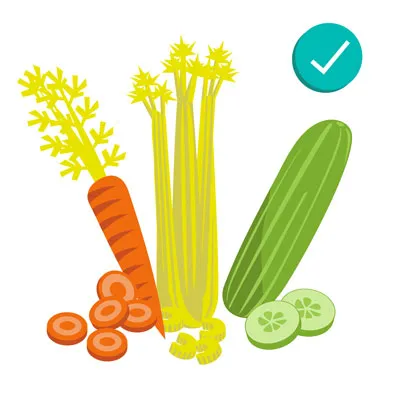 Carrots, cucumber slices, and celery sticks, illustrating safe vegetables for dogs
Carrots, cucumber slices, and celery sticks, illustrating safe vegetables for dogs
These low-calorie vegetables are excellent crunchy treats, particularly for overweight dogs. They provide vitamins, minerals, and can even help with dental health (carrots) or bad breath (celery).
8. Cheese
 Small pieces of cheese, noting its safety in moderation for dogs
Small pieces of cheese, noting its safety in moderation for dogs
If your dog isn’t lactose intolerant, small amounts of low-fat cheese can be an acceptable treat. Avoid high-fat varieties and large quantities.
9. Peanuts, Peanut Butter, and Cashews
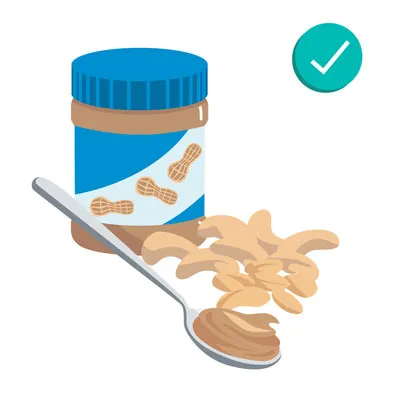 Peanuts, peanut butter, and cashews, showing safe nut options for dogs
Peanuts, peanut butter, and cashews, showing safe nut options for dogs
Unsalted, unflavored peanuts and cashews are safe in very small quantities due to their high-fat content. Peanut butter is a popular treat, but ensure it’s unsalted and free of xylitol.
10. Popcorn and Corn
 Popcorn and corn kernels, highlighting their safety for dogs when plain
Popcorn and corn kernels, highlighting their safety for dogs when plain
Air-popped, unsalted, and unbuttered popcorn can be a fun treat. Ensure all unpopped kernels are removed. Plain corn (off the cob) is also safe.
11. Coconut and Honey
 Coconut halves and honey in a jar, discussing their benefits and moderation for dogs
Coconut halves and honey in a jar, discussing their benefits and moderation for dogs
Small amounts of coconut (flesh, milk, oil) can be fine, possibly aiding with allergies, but some dogs may experience stomach upset. Avoid coconut water and the furry shell. Honey in moderation offers vitamins and minerals.
12. Grains, Wheat, and Quinoa
 Various grains, wheat, and quinoa, confirming their acceptability for dogs
Various grains, wheat, and quinoa, confirming their acceptability for dogs
Many commercial dog foods contain grains, wheat, and quinoa. Small amounts of these cooked items are generally fine, but always watch for signs of allergic reactions.
13. Green Beans
 Fresh green beans, emphasizing their healthy and safe qualities for dogs
Fresh green beans, emphasizing their healthy and safe qualities for dogs
Green beans, whether raw, steamed, or from a can (without added salt or spices), are a safe, healthy, and low-calorie treat many dogs enjoy. Cut them into bite-sized pieces to prevent choking. Knowing what are all the foods dogs can’t eat is as important as knowing what they can.
What Dogs Are Most at Risk if They Consume Toxic Foods?
While all dogs should avoid toxic foods, certain factors increase a dog’s vulnerability:
- Small breeds vs. large breeds: Smaller dogs are more susceptible to toxicity due to their lower body weight, meaning even small amounts of harmful substances can have a more profound effect.
- Puppies: Young dogs have less developed digestive and immune systems, making them more vulnerable to bacterial infections and digestive upsets.
- Elderly dogs: Older dogs may have compromised immune systems or pre-existing health conditions that put them at higher risk from toxic substances.
- Dogs with pre-existing conditions: Dogs with health issues like diabetes, kidney disease, or pancreatitis are at greater risk of severe complications from ingesting harmful foods.
How To Prevent Dogs from Eating Toxic Foods
Accidents can happen, but proactive measures can significantly minimize the risk of your beloved pup ingesting unsafe human food.
1. Store Foods Out of Reach
Ensure all potentially toxic foods are stored securely where your dog cannot access them. This means keeping dangerous items on high shelves, in locked cabinets, or in containers your dog cannot open. Never leave toxic foods unattended on countertops or low tables.
2. Avoid Feeding Dogs from Your Plate
Resist the urge to feed your dog scraps directly from your plate or while you are cooking in the kitchen. This practice not only reinforces begging behavior but also increases the chances of accidentally giving them something harmful. It’s safest to only provide treats specifically formulated for dogs.
3. Educate Family Members and Guests
Ensure everyone in your household, including children and guests, understands the importance of not feeding your dog human food, no matter how much they beg. Clearly communicate which foods are off-limits.
4. Be Careful During Holidays and Gatherings
Holidays and social gatherings often involve an abundance of rich human foods, increased distractions, and a relaxed atmosphere, making it easier for dogs to access forbidden items. Be extra vigilant during these times. Keep food sealed, supervise your pet closely, and ensure guests are aware of feeding rules.
If, despite your precautions, your dog eats something toxic, being prepared can make a critical difference. Keep emergency veterinarian contact information readily available, along with details for poison control hotlines that are accessible 24/7.
What To Do if Your Dog Eats Something Toxic
Prompt action is essential if you suspect your dog has eaten toxic food. Recognizing the symptoms of food toxicity can help you react quickly. These symptoms vary depending on the substance ingested but can include listlessness, distress, pain, vomiting, diarrhea (sometimes bloody), excessive drooling, tremors, or seizures. In some cases, a dog’s stomach may become bloated and hard to the touch due, which can be a sign of a severe, life-threatening condition.
If you observe any of these symptoms or suspect ingestion:
- Call Your Veterinarian or Poison Control Immediately: Timing is critical. Early intervention significantly improves treatment outcomes and can reduce hospitalization time.
- Be Prepared with Information: Have all relevant details ready, including the type of food eaten, the approximate amount consumed, and the time of ingestion. This information helps your vet determine the best course of action.
- Avoid Home Remedies Unless Advised: Do not attempt to induce vomiting or administer any home remedies without explicit instructions from your veterinarian or a poison control expert. Depending on the substance, inducing vomiting can sometimes be more harmful.
Conclusion
Understanding “what is the one meat that dogs should avoid” is a crucial step in ensuring your canine companion’s health and safety. While the answer often points to raw or undercooked meat due to bacterial and bone hazards, it’s equally vital to recognize the dangers of fatty cuts, processed meats, and any meat prepared with toxic human ingredients like onions or garlic.
By being vigilant about food storage, educating your household, and understanding which human foods are strictly off-limits, you can create a safer environment for your dog. Remember, there are many wholesome and safe human foods, including lean cooked meats and various fruits and vegetables, that can be wonderful treats when given appropriately and in moderation. Always consult your veterinarian if you are unsure about any food or if your dog accidentally ingests something harmful. Your proactive care makes all the difference in keeping your furry friend happy, healthy, and safe.
References
- “Top 10 dog poisons,” Hilary Parker (5/2023), WebMD, https://www.webmd.com/pets/dogs/top-10-dog-poisons
- “What happens if a dog eats chocolate?” (10/2023), Colorado State University, https://vetmedbiosci.colostate.edu/vth/animal-health/why-is-chocolate-bad-for-dogs/
- “Fruits and vegetables dogs can or can’t eat,” (3/2024), American Kennel Club, https://www.akc.org/expert-advice/nutrition/fruits-vegetables-dogs-can-and-cant-eat/
- “What to do if your dog drinks alcohol,” Jerry Klein (7/2023), American Kennel Club, https://www.akc.org/expert-advice/vets-corner/is-alcohol-dangerous-for-dogs/
- “Can dogs eat apples?” Hector Joy (12/2022), PetMD, https://www.petmd.com/dog/general-health/can-dogs-eat-apples
- “Can dogs eat plums?” Katie Koschalk (7/2023), Chewy, https://be.chewy.com/nutrition-pet-diet-tips-can-dogs-eat-plums/
- “Avocado (Persea spp) Toxicosis in Animals,” Cristine Hayes (9/2024), Merck Veterinary Manual, https://www.merckvetmanual.com/toxicology/food-hazards/avocado-persea-spp-toxicosis-in-animals
- “People foods to avoid feeding your pets,” (n.d.), ASPCA, https://www.aspca.org/pet-care/animal-poison-control/people-foods-avoid-feeding-your-pets
- “People foods dogs can and can’t eat,” (3/2024), American Kennel Club, https://www.akc.org/expert-advice/nutrition/human-foods-dogs-can-and-cant-eat/
- “Can dogs eat nuts?” Amanda Ardente (1/2023), PetMD, https://www.petmd.com/dog/nutrition/can-dogs-eat-nuts
- “Can dogs drink milk?” Sandra C. Mitchell (1/2024), PetMD, https://www.petmd.com/dog/nutrition/can-dogs-drink-milk
- “Can dogs have nutmeg?” Barri J. Morrison (11/2023), PetMD, https://www.petmd.com/nutmeg-safe-dogs
- “Onion, garlic, chive, and leek poisoning in dogs,” Renee Schmid et al. (2024), VCA Animal Hospitals, https://vcahospitals.com/know-your-pet/onion-garlic-chive-and-leek-toxicity-in-dogs
- “Can dogs eat tomatoes?” Anna Burke (10/2024), American Kennel Club, https://www.akc.org/expert-advice/nutrition/can-dogs-eat-tomatoes/
- “Can dogs eat potatoes?” Katherine Ripley (11/2023), American Kennel Club, https://www.akc.org/expert-advice/nutrition/can-dogs-eat-potatoes/
- “What to do if your dog eats a cigarette butt,” (6/2023), American Kennel Club, https://www.akc.org/expert-advice/health/dog-ate-cigarette-butt/
- “Dough & dogs: Why it’s bad and what you can do,” Lisa Goldstein (7/2024), Preventive Vet, https://www.preventivevet.com/dogs/dough-is-toxic-to-dogs
- “Rhubarb,” (n.d.), Pet Poison Helpline, https://www.petpoisonhelpline.com/poison/rhubarb/
- “Can dogs drink carbonated water?” Heather Logue (n.d.), Rover, https://www.rover.com/blog/can-dogs-drink-carbonated-water/
- “What fruits can dogs eat?” Ellen Malmanger (2/2024), PetMD, https://www.petmd.com/dog/nutrition/what-fruits-can-dogs-eat
- “Can dogs have green beans?” Anna Burke (8/2022), American Kennel Club, https://www.akc.org/expert-advice/nutrition/can-dogs-have-green-beans/
- “About pet food safety,” (4/2024), CDC, https://www.cdc.gov/healthy-pets/about/pet-food-safety.html
